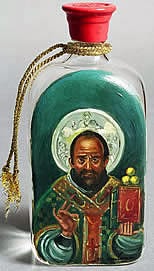
In 1949, Simone De Beauvoir wrote
The Second Sex as an early argument for pre and post-war feminism, largely influenced by existentialism. It pre-dates Betty Friedan's
Feminine Mystique (1963) by about 14 years, and was published in French. The two works together form the catalyst for the worst of feminism today. As for the best of feminism, I specifically have in mind Wojtyla's understanding of female saints of his day, as contemporaries of De Beauvoir, emobodying "feminine genius" and not "feminine mystique"!
Some background on Simone De Beauvoir (special thanks to TMIY, http://www.slideshare.net/PDEI/light-to-the-nations-week-10?from_search=4):
1) Born and raised in Paris, France
2) After WWI, her family underwent financial crisis and she attended a local convent for her education
3) She became an atheist at age 15
4) At about age 20, she began a lifelong friendship with Jean-Paul Sartre and claimed him, Hegel, and Leibniz as her main philosophical influences
A key concept to Sartre's philosophy included: woman "being-in-itself", and man "being-for-itself". In other words, men were geared for 'freedom', and women were merely geared for 'commitment'. De Beauvoir's Second Sex aimed at destroying women's dependence on 'commitment' by divorcing women's maternal dimension from their social/'professional' lives. She is said to have taken these practical steps to bring such a change about:
1) Insistence that girls be raised without dolls, houses, and traditionally 'feminine' things
2) Discouragement of women to stay home and raise children
3) Encouragement of young women to strive for professional success at all costs
4) Wrote and signed French women's "Manifesto of the 343", numbering in the millions of women, who had had an abortion for the sake of advancing career and demanded free birth control

Compared with the Magna-Carta-like scale of Second Sex, Betty Friedan's Feminine Mystique was a simple amendment for the cause of feminism. But it's timing was much more effective, as the second generation of women since the War were more susceptible to revolution in the 1960s, especially in regard to sex. Worldwide, women's mindsets altered drastically from interdependent to independent, thanks to the work of De Beauvoir and Friedan. Colleges and Universities began offering "Women's Studies" programs with more depth added to radical feminism by diversity of class and race. Within two decades, the 'normal' understanding of women's roles and biology had morphed entirely into an obscure indecipherability from that of men. Androgyny had become the socially constructed norm, as the outdated heteronormative view was only permitted for select Arab, Indian, and Israeli peoples.
What began as Sartre's differentiations between men and women (freedom and commitment), ended with just freedom/'being-for-itself'. This is the state of things today in most countries, namely, a lack of identity in the most fundamental sense of male and femaleness. Such is the case with the global push for same sex marriages, a kind of 180 degree turn from less than a century prior. {I do not want to be misunderstood here to mean that same sex attraction is a result of 20th century philosophy. That would be folly. What I mean is that from a modern philosophical and legal standpoint, there is little reason left to uphold the view of marriage between one man and one woman)
What were some of the outide socioeconomic pressures in Europe during the world wars? In other words, what may have been contributing factors to such outlandish philosophies of the last century?
Death Toll
A) European casualties in WWI= 15,893,629 enrolled men(http://www.pbs.org/greatwar/resources/casdeath_pop.html) Note: does not include Great Britain or Russia. France's total casualties (alone) of enrolled men=6,160,800
B) European casualties in WWII= 5,217,700 enrolled men (http://www.world-war-2.info/statistics/) Note: ibid^
Civil Service/Employment
C) Many women were forced to enter the workforce by governments during wars
D) On account of so many male deaths, women needed to support themselves
E) Higher education determined higher salary, etc.
I am not so naive as to think that the 20th century was not traumatic for women on both a macro and a microscopic level. And that even some of those who held to the age-old understanding of the human person grew desparate and disillusioned by war, hatred, and the overall problem of evil. My post is not intended to condemn feminism or its founders, misguided though they may have been. I very much hope that the guinea pigs of the movement (men and women both) have run their course and will teach future generations what not to do. But again, I am not so naive, and I estimate that at least another generation is gearing up to implement the philosophies of its founders.
Proof of my estimation is largely found in legislation. De Beauvoir's "Manifesto of 343" has been internationally legal in various forms for nearly half a century (Roe v Wade, etc.). Likewise, same sex marriage was just legalized in France this past year (2013). Unfortunately, legislation tends to outlive generations.
But where documents like that of Friedan and De Beauvoir thrive, so do that of great minds like Von Hildebrand, Wojtyla, Lewis, and others! I want to draw attention, particularly, to John Paul II's "Mulieris Dignitatem" as the medicene for the wounds inflicted by De Beauvoir. Otherwise, De Beauvoir's work communicates that womanhood in itself is undignified, which is fallacious. The woman as a human person, in reality, is central to the history of salvation and cannot, therefore, be replaced by androgyny. Nor can she be replaced by women trying to embody the worst vices of men, like Sartre, whom JPII seems to be directly addressing in his letter:
In the name of liberation from male 'domination', women must not appropriate to themselves male characteristics contrary to their own feminine 'originality'. There is a well-founded fear that if they take this path, women will not 'reach fulfilment', but instead will deform and lose what constitutes their essential richness. ("Mulieris Dignitatem", #10)
The limitation placed on man and woman by Sartre and De Beauvoir's philosophy finds a direct contrast in the thought of Wojtyla. Where the former limit man to 'freedom', Wojtyla calls man to 'responsibility'. Likewise, where they limit woman to 'commitment', Wojtyla affirms woman as 'gift'. These are not mutually exclusive terms either, since Wojtyla perfects the original terms with their logical conclusions.
In "Mulieris Dignitatem", John Paul II also presents the unsaid conclusion to De Beauvoir's feminist program, namely, 'dominance'. Since De Beauvoir understood man's freedom to be 'dominating' of women, she wanted to empower women to do the same. Ironically, neither sex benefits from dominance, but rather, 'service' remains the key to reigning with dignity ('to serve is to reign'). In the end, 'dominance' only robs women of their fundamental right to reign in a specific sphere of humanity: maternity.
Thus, we have the basic principles from JPII in place for refuting De Beauvoir and Friedan's feminism, but how are they practically lived in today's world? A world where men's and women's occupations and professions are nearly interchangeable, where family's are redefined, and where confusion remains as to what the authentic expression of sexual identity is.
Again, JPII offers a simple, but forgotten, answer. For women, the self-giving service of maternity is not optional. Whether married or celibate, a woman can and must realize her maternal vocation and identity. Divorcing her body from her career, refusing to serve in her home, rejecting the Intelligent Design of her person by the Creator are all decisions for 'dominance' and not for 'gift'.
Visibly and daily, marriage between a man and a woman presents an obvious portrait of such service. Children are an excellent reminder of women's cooperation in the history of salvation, as a type of memorial of the Incarnation to which Mary addressed her 'fiat'. Indeed, without Mary's cooperation, the Incarnation would have been thwarted.
To expand on how unmarried or purposely celibate women live authentically, again, maternity is non-negotiable, although its expression is different from marriage. The authentic expression can be applied to the workplace for women in the secular world (though persecuted), as much as it can be applied to a convent or abbey. For a hypothetical example, the widowed queen of France can either choose to 'dominate' or 'serve' the common good by approving or disapproving of unethical legislation, and behaving in a way that befits her office as a high-profile woman who influences others.
Likewise for a nun, the opportunity for 'dominance' is just as accessible as 'service'. In my opinion, we have seen a majority of the LCWR display the incorrect expression of their femininity since the sexual revolution. The alternative are nuns who exercise their maternal authority in obedience, respect, and conformity to the example of the Theotokos.
The final question I want to ask is, would JPII have come to the conclusions he did without the bad examples of De Beauvoir, Sartre and others? In other words, is "Mulieris Dignitatem" just a conservative reaction to the feminist movement gone out of control? I would argue that that is not the case. Instead, I believe that Wojtyla's understanding of the human person is inspired by God first, and is seen to have always been lived out in the Church. As much as De Beauvoir was a contemporary of Wojtyla, so was Mother Theresa of Calcutta, St. Faustina, and St. Mrs. Gianna Beretta Molla.
The Church has always and will always hold the keys to authentic masculintity and feminity, because she(the Church) was founded by the One God in three Persons who said, "Let us make man in our image and likeness...male and female".












